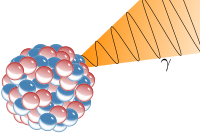
Gamma-ray observations of low-luminosity active galactic nuclei
Sign Up to like & getrecommendations! Published in 2020 at "Monthly Notices of the Royal Astronomical Society"
DOI: 10.1093/mnras/staa083
Abstract: The majority of the activity around nearby (z ~ 0) supermassive black holes is found in low-luminosity active galactic nuclei (LLAGN), the most of them being classified as low ionization nuclear emission regions. Although these… read more here.
Keywords: gamma ray; active galactic; luminosity active; gamma ... See more keywords

Constraining X-ray reflection in the low-luminosity AGN NGC 3718 using NuSTAR and XMM–Newton
Sign Up to like & getrecommendations! Published in 2020 at "Monthly Notices of the Royal Astronomical Society"
DOI: 10.1093/mnras/staa1762
Abstract: One distinctive feature of low-luminosity active galactic nuclei (LLAGN) is the relatively weak reflection features they may display in the X-ray spectrum, which can result from the disappearance of the torus with decreasing accretion rates.… read more here.
Keywords: xmm newton; reflection; ngc 3718; low luminosity ... See more keywords

A decades-long fast-rise-exponential-decay flare in low-luminosity AGN NGC 7213
Sign Up to like & getrecommendations! Published in 2018 at "Monthly Notices of the Royal Astronomical Society"
DOI: 10.1093/mnras/stx3259
Abstract: We analysed the four-decades-long X-ray light curve of the low-luminosity active galactic nucleus (LLAGN) NGC 7213 and discovered a fast-rise-exponential-decay (FRED) pattern, i.e. the X-ray luminosity increased by a factor of $\approx 4$ within 200d,… read more here.
Keywords: decades long; fast rise; luminosity; ngc 7213 ... See more keywords

Type II supernovae in low-luminosity host galaxies
Sign Up to like & getrecommendations! Published in 2018 at "Monthly Notices of the Royal Astronomical Society"
DOI: 10.1093/mnras/sty1581
Abstract: We present an analysis of a new sample of type II core-collapse supernovae (SNe II) occurring within low-luminosity galaxies, comparing these with a sample of events in brighter hosts. Our analysis is performed comparing SN… read more here.
Keywords: host galaxies; type supernovae; luminosity; host ... See more keywords

High-resolution observations of low-luminosity gigahertz-peaked spectrum and compact steep-spectrum sources
Sign Up to like & getrecommendations! Published in 2018 at "Monthly Notices of the Royal Astronomical Society"
DOI: 10.1093/mnras/sty564
Abstract: We present Very Long Baseline Interferometry observations of a faint and low-luminosity ($L_{\rm 1.4 GHz} < 10^{27}~\mbox{W Hz}^{-1}$) Gigahertz-Peaked Spectrum (GPS) and Compact Steep Spectrum (CSS) sample. We select eight sources from deep radio observations… read more here.
Keywords: radio; luminosity; peaked spectrum; spectrum ... See more keywords

Hot gas flows on a parsec scale in the low-luminosity active galactic nucleus NGC 3115
Sign Up to like & getrecommendations! Published in 2019 at "Monthly Notices of the Royal Astronomical Society"
DOI: 10.1093/mnras/stz3474
Abstract: NGC 3115 is known as the low-luminosity active galactic nucleus that hosts the nearest (z ∼ 0.002) billion-solar-mass supermassive black hole (∼1.5 × 109 M⊙). Its Bondi radius rB (∼3.6 arcsec) can be readily resolved with Chandra, which… read more here.
Keywords: active galactic; radius; gas; luminosity active ... See more keywords

From radio-quiet to radio-silent: low-luminosity Seyfert radio cores
Sign Up to like & getrecommendations! Published in 2019 at "Monthly Notices of the Royal Astronomical Society"
DOI: 10.1093/mnras/stz595
Abstract: A strong effort has been devoted to understand the physical origin of radio emission from low-luminosity AGN (LLAGN), but a comprehensive picture is still missing. We used high-resolution ($\le$1 arcsec), multi-frequency (1.5, 5.5, 9 and… read more here.
Keywords: radio emission; radio; radio quiet; low luminosity ... See more keywords

A compact jet at the infrared heart of the prototypical low-luminosity AGN in NGC 1052
Sign Up to like & getrecommendations! Published in 2019 at "Monthly Notices of the Royal Astronomical Society"
DOI: 10.1093/mnras/stz716
Abstract: The feeble radiative efficiency characteristic of Low-Luminosity Active Galactic Nuclei (LLAGNs) is ascribed to a sub-Eddington accretion rate, typically at log (Lbol/Ledd) ≲ −3. At the finest angular resolutions that are attainable nowadays using mid-infrared (mid-IR)… read more here.
Keywords: ngc 1052; continuum; compact jet; low luminosity ... See more keywords